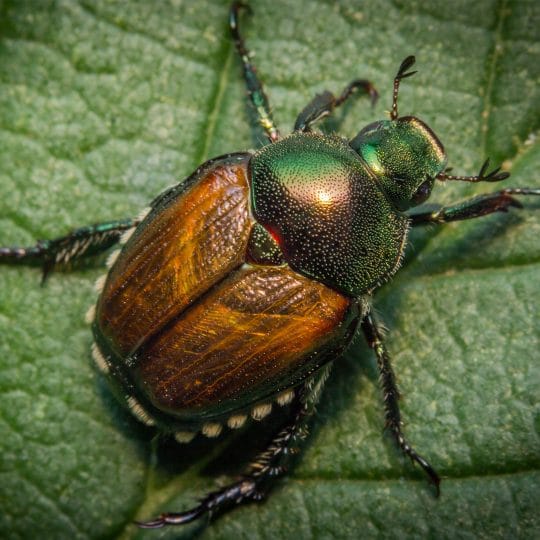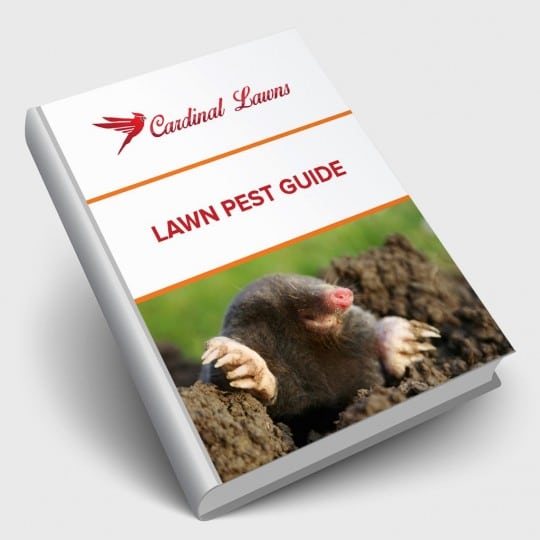Signs of Japanese Beetles
and How to Prevent an Infestation
Posted
December 14, 2017

For a small bug that’s travelled across the world in the early 1900s, Japanese beetles don’t easily tire from eating your plants. If you’re not already aware of these garden pests, here’s how to identify the signs of Japanese beetles, and how to get them out of your garden.
Signs of Japanese Beetles
If you notice a half inch, winged insect with a blue-green head and copper back, chances are you’re looking at a Japanese beetle. They usually feed in groups, so if you see one, there’s probably more. They also frequent your rose, bean, grape, and raspberry plants. This doesn’t mean they won’t be tempted by everything else in your garden. In fact, Japanese beetles are known to feed on over 200 species of plants.
You may start to see tiny, white grubs with brown heads in your soil in the early summer. These are baby beetles, and they can stay cozy in your soil for about 10 months, even over winter. Come next summer, the babies will have grown into hungry beetles. Now they’re ready to leave their safe house to dine on whatever is close by. You can tell they’ve been in your garden if you see skeletonized leaves—with only the veins remaining.
Japanese Beetle Prevention
Proper care of your lawn and garden, including regular watering and fertilizing, can help reduce the damage caused by beetles. Remove any dead, dying or diseased plants, especially fruit plants which may produce an attractive odor to the beetles. If you notice your soil is overrun by grubs, you can spray your lawn with soapy water, forcing the grubs to surface, and the birds to feast—ridding your lawn of future beetles.
Ridding Your Lawn of Japanese Beetles
Another way of preventing damage is to get rid of the beetles altogether. Here are some suggestions:
- The most effective way of getting rid of Japanese beetles is by picking them off your plants by hand. It’s a tedious process, but it ensures they’re off, and you can drop them into soapy water to make sure they don’t come back.
- Cover your plants during the beetle’s six to eight week summer feeding period. Put a drop cloth down overnight. Go out in the early morning when the beetles are most active and shake them off into a bucket of soapy water.
- Apply neem oil and sprays containing potassium bicarbonate on your plants—especially roses. The beetles ingest it and pass a chemical onto their eggs, and the resulting larvae die before they become adults.
- Insecticides are another option, but should be discussed with a local authority about which ones are approved in your area.
- Japanese beetle traps can be helpful in controlling large numbers of beetles, but they also might attract beetles from across the neighborhood. The aromatic chemicals used in these traps also attract other insects, opening your yard to even more possible damage. If traps are used, they should be placed far from prized plants so beetles don’t make a pit stop along the way.
- A can of fruit cocktail can be just as aromatic and attractive as a trap. Open the can and let it sit in the sun for a week to ferment. Then place it on top of blocks in a light-colored container filled with water just below the top of the can. Place it about 25 feet from the plants you want to protect. The beetles will head for the sweet bait, fall into the water, and drown. If rain dilutes the bait, start over.
- You can also use certain plants as traps. Japanese beetles are attracted to geraniums. Eating the blossoms cause them to get dizzy and fall down—giving you the opportunity to dispose of them. Plant geraniums close to more valuable plants which you wish to save from the beetles. There are also certain plants, like garlic and rue, that deter the bugs as well.
If you’ve tried all of the above and are still having issues with Japanese beetles making skeletons of your plants, contact the pest specialists at Cardinal Lawns for more help.

Download Your FREE Lawn Pest Guide
Pests become most prevalent during the heat and humidity of summer. Take some time to learn about the signs of infestations before any damage can be caused to your landscape. This handy guide will teach you how to spot common lawn pests and how to keep them from causing harm to you and your property.